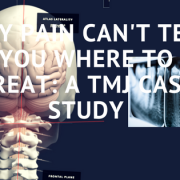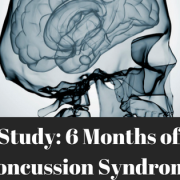Why Pain Can’t Tell You Where You Need Treatment: A TMJ Case Study

Jaw pain/TMJD is a very frequent problem we see in the office. It’s so frequent that I spend one day each week inside of a dental office in West Palm Beach doing consultations with a great local area dentist that specializes in pain syndromes of the jaw.
Most of the patients that see us with jaw pain have already seen a variety of jaw specialists. They’ve had MRI’s done, mouth pieces made, and various therapies done on the area of pain.
The problem of course is that pain, especially chronic pain, does a poor job of telling us what is wrong with you. Chronic pain is complex. Chronic pain is misleading. Chronic pain is also a poor locator for pathology.
Identifying the Pain Source
One of the common questions asked during a case history is to highlight or point to the area where you feel pain. It can be useful sometimes when pain patterns are reflecting specific nerve roots, and it also gives a general vicinity for a doctor to examine more closely. For most cases of chronic pain, examining the area of injury often leads to dead ends. There’s no damaged tissue to treat or remove that’s likely to explain why someone hurts.
Patients with TMJ pain frequently seek the treatment of these specialized dentists, and most of them do really well when in the right hands. However, sometimes jaw pain isn’t truly a problem in the jaw. Sometimes it’s a pain problem somewhere else in the body.
I recently took care of a patients who were was referred by another chiropractor. The patient had been to 6 different jaw and mouth specialists but could not get any form of relief from treating the jaw.
When we examined the patient, we didn’t pay much attention to the jaw itself. The patient already had imaging and tests done to their mouth already, so I wanted to spend my time elsewhere.
We found that the patient had poor motion in their shoulder and neck area on the right side. They were also showing a large amount of forward head posture characteristic of anterior head syndrome. Surprisingly, the patient’s jaw seemed to move pretty well. There wasn’t the clunky abnormal opening and closing of the jaw that you would usually see in a TMJ where the jaw displays a large side to side movement. From my view, the patient’s jaw movement looked really great, but the patient’s neck was moving poorly.
Correct the Neck and Pain Self-Resolves
We did our normal protocols with this patient. We did a gentle NUCCA correction to the patient’s neck. We post-x-rayed the neck to verify a neck improvement, and then we waited. You can see the x-ray results below.

Pre and Post X-ray shows a small shift, but an almost perfect correction.
3 days after her first appointment, we had our first follow-up appointment scheduled. The patient had gone 3 consecutive days without any jaw pain at all for the first time in 2 years!
Pretty good, but would it last?
3 months later, we re-examined the patient. The patient was now going 1 month between appointments because it would be important to see if the patient could go that long a distance between appointments without pain. The jaw was still moving normally, but now their head and neck could move in all ranges of motion smoothly. The patient also stopped showing a persistent right tilt of their head.
Most importantly, the patient could now talk with no restrictions, and had no more food limitations on what she could eat. For all intents and purposes, she became a normal teenager again.
Final Thoughts
Now if we had kept on trying to treat the jaw and identify pathology in the jaw, would she still have gotten better?
It’s hard to say, but after 2 years of doing every jaw therapy under the sun, it just seemed to make sense to look at other pieces of anatomy.
The complexity of chronic pain often means that we can’t look at things linearly. We have to know that someone has pain in one region, but we also have to think about all the different anatomy that shares a connection with the part of the body that hurts. This doesn’t mean that every person with chronic jaw pain will get better from a neck adjustment, because that’s not true either.
It means that we have to take care of people and see them for what they are globally instead of treating them as an object with a specific piece of meat that hurts today.







